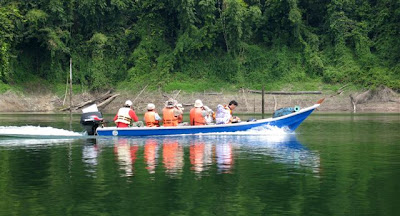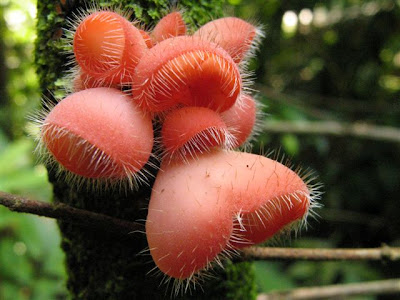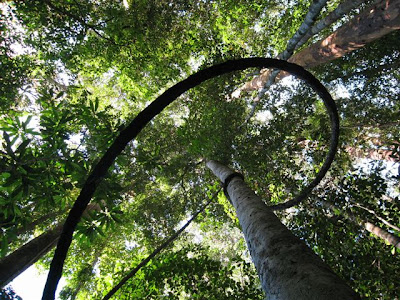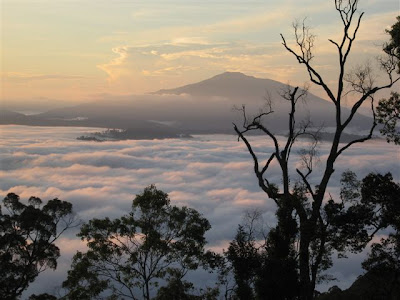Maliau Basin Bird-watching
Text by Peter Stevens
Photos by Ian Hall
INTRODUCTION
From November 7th to 15th 2005, I had the opportunity to trek and bird watch in the Maliau Basin Conservation Area, Sabah, Malaysia. I was accompanied on the trip by Ian Hall, who at that time was working with Yayasan Sabah as a volunteer architect to identify and design ecologically-friendly visitor and research facilities within the conservation area. He has spent many weeks in all of the Yayasan Sabah-run forest reserves (Danum, Imbak, Maliau) and is an observant, if new, birder. Over the 8 days spent inside the reserve proper we recorded 125 species, 6 of which, I believe from past records, have not previously been recorded in the MBCA. Prior to my arrival Ian had been working in the reserve since August 27th and had seen an additional 16 species, 1 of which (Hose’s Broadbill) was new, making a combined list is 141/7.
MALIAU BASIN, BACKGROUND.
In the heart of Sabah is the so-called “Lost World” of the Maliau Basin. This is a huge bowl, some 390 sq km of pristine rainforest surrounded by cliffs that rise to 1700m at their highest. It is just 40km north of the Indonesian border with Sabah and has Danum Valley to its east and Imbak Canyon to the north. In 1997 is was gazetted as a Class 1 conservation area and extended to include a buffer zone of some 200 sq km of unlogged forest outside the rim of the basin. A feature of the basin is its amazing number of waterfalls, of which the Maliau Falls are the biggest, and the upland heath forest, which is both rare and endangered and just dripping with pitcher plants and orchids.
The first organized expedition was as recent as 1982, followed by a much more extensive scientific survey in 1988. There were further trips in 1999 – 2001 which produced a bird list of 271 species. There seems to have been little in the way of casual birding trips by private individuals, I guess mainly because of its remoteness and that you have to trek for several hours every couple of days with all your food and gear! The cold beer and balcony at Danum are much more inviting!
So what was I doing there? Some of you might remember my trip last year into similar habitat in Imbak Canyon while working as a volunteer with Raleigh International. Ian was on the same expedition and when he heard that I was heading down that way anyway, arranged an all expenses-paid trip (except flights and food) into Maliau if I would train some of the rangers in the dark art of birdwatching and produce a bird report of the trip. ‘Rude not to really’, thought I.
Maliau Rangers comparing notes on ‘The Birds of Borneo’
GETTING THERE.
I flew to Kota Kinabalu from Manila, then on to Tawau, where I was met by Ian and started the 5 hour 4 WD trip to the main gate. It was bloody awful. There was major road construction going on for about half the trip so we ran the gauntlet of construction vehicles and logging trucks (lots of them). The good news is that it will make the journey much more bearable sometime next year!
Peter stands by a large Agathis Tree
ACCOMMODATION AND BIRDING
Our base was Agathis Camp (named after a species of very big tree!) which is on the banks of a small river and on the edge of the primary forest. This is the normal starting point for visitors and has accommodation for about 20 people, with a kitchen, clean toilets and showers. There are a number of trails starting from here so I spent the next couple of days exploring and birding. The habitat was typical primary dipterocarp – huge trees, some mid-storey growth and mainly open forest floor. The birding was also typical primary forest – long slow periods interrupted by some spectacular birds, the best of which were stunning views of Banded Pitta. I also heard Blue Headed Pitta but didn’t get onto one. Blue Banded and Giant Pitta are also supposedly in the area.
The access road to the camp was through reasonable secondary forest and was well worth the late afternoon walk. Two White-fronted Falconets, an endemic, topped off a good first day’s birding, in which I saw 32 species.
The next day was spent with some rangers, going over bird tapes that I had brought with me and then going out to find the birds. In the afternoon I sat with a warm beer scanning the trees around the camp through the scope. A pair of Scarlet-rumped Trogons were very obliging and complemented the Diard’s Trogon of earlier in the day. Together with the various babblers, bulbuls, broadbills, barbets and big hornbills (Helmeted and Rhinoceros) I ticked off 46 for the day. A few more warm beers and a tot of rum rounded off a good day and set me up for the trek ahead.
Unfortunately Ian, who had been ill with the flu, was not up to the walk, so I birded the same area again the next day, with a little more exploration, and added 9 to the list, out of a day’s total of 41. The new ones included Great Slaty Woodpecker and Jambu Fruit Dove, which was a new record for the camp.
The next day Ian was still not up to it so I set off with two guides for the trek to Camel Trophy Camp. This was built in 1993 by the Camel Trophy team and is 8 km away through the forest. It was also half a kilometer higher than Agathis, most of which was climbed in the first couple of k.’s. It was so steep in places that aluminium (and some wooden) ladders have been erected to help the climber. It was a little knee-wobbling, especially with a heavy pack but I was on an adrenaline rush as we had seen Red-bearded Bee-eater within a few minutes of the start of the ascent. This was pretty close to the top of my ‘must see’ list so I was a happy camper.
After the climb we continued through primary dipterocarp forest. Slowly the character of this changed. The trees got smaller and the canopy got lower. The open, clear floor changed to dense stands of thin ‘treelings’ through which visibility was reduced to a few metres. Underfoot the path became boggy and sandy and the side coated in mosses. This was the heath forest. The canopy was by now only a few metres high and some of the trees were entwined with amazing collections of pitcher plants. These ranged in size from a good beer-mug to a small sherry glass. In fact we were skirting the edge of the main heath forest and it soon reverted to the familiar big trees and after about 4 hours we arrived at Camel Trophy camp. This had a first floor balcony which overlooked a cleared area about 300m by 50m. The effect of this was to provide dense secondary growth and bushes around the clearing which gave a more varied habitat than the primary forest itself.
There were, accordingly, many more birds around the clearing than in the forest, and also a low tree with lots of flowers and small fruits, which fortunately, was at around balcony level and within easy scoping distance. Suddenly the burden of lugging the scope up the escarpment seemed worthwhile. It was soon set up and in use. This particular tree was always busy with birds, come rain or shine, and provided excellent views of several species of spiderhunter as well as flowerpeckers and a white-eye. This was the only venue on the whole trip that produced some good mixed flocks, with bulbuls, scimitar babblers, fantails etc. and, just on dark and as predicted – Malaysian Eared Nightjar. There were also 2 – 3 Great Slaty Woodpeckers which flew across the clearing in the late afternoon every day, as well as a very quick view of what was probably a Besra which drifted across right in front of the balcony late one evening. The Ashy Drongo on the tree right next to us was new for Ian (who joined me the next day), as were the endemic Chestnut-crested Yuhinas, which put in an obliging appearance to the side of the balcony.
In the morning I plucked up the courage to tackle the 100 rungs on the vertical ladder up a huge Agathis tree to a canopy platform (similar to, but not so rickety, as the one in Danum). It was a trip well worth the effort and yielded several birds new to our list in just a few minutes. These included Scarlet Minivet, Grey and Buff Woodpecker and Purple-throated Sunbird, together with fantastic, right-in-front-of-my-nose views of the common, but beautiful, Temmink’s Sunbird.
As the days were passing rapidly, we packed up and headed out another 10ks to Lobah Camp, passing through the core heath forest en route. I guess it was the relative dampness of the heath forest, followed by deep leaf-litter, but I collected 49 leeches from on, in and around my boots at the end of this walk. Thank goodness for leech-socks and good insect repellent below my shorts!
Lobah camp is less sophisticated than Camel Trophy (hammocks under blue tarps) but has a great view from the heli-pad of a huge area of the basin. It will also be the site of new accommodation in the next year or so. It also has great views of Grey-rumped Treeswifts and the aerodynamic kings of the skies Brown Needletails. These guys whooshed past at head-height, living up to their reputation as the fastest bird in straight flight in the world.
We were enjoying the spectacle when I happened to look behind me and nearly fell over – a small, very dark, falcon was circling the lookout, harassed by the Treeswifts. It passed directly overhead a couple of times, at very close range in the failing light. It was dark rufous underneath, without any white or streaking. The head was also quite dark, with no white contrasts around the ‘teardrops’. ‘Hobby’ was the first word into my head, but no hobby that I had ever seen. A quick look at the book soon came up with Oriental Hobby a rare vagrant to Borneo. Double rum ration all round! (Ian has subsequently seen one perched near Agathis Camp).
A late afternoon flurry also added Pale Blue and Blue and White flycatcher to the list, the latter being a new record for the MBCA.
The next day was the long (10k) but relatively downhill walk back to our starting point at Agathis. ‘Downhill’ was purely ‘relative’ and included a couple of steep ups and downs into and out of river valleys, particularly near the beautiful Ginseng Falls. After that it was easy walking with a couple of birding highlights, including around 5 Bornean Bristleheads high in the canopy, and a female Blue-headed Pitta on the track. It was good pheasant country too and the guides said that Bulwer’s was fairly regularly seen by them along this trail.
Our trip finished back in the 4WD heading out of the reserve. On the way we picked up the delightful Silver-rumped Swift on the road and a Tiger Shrike at the gate. Ian had previously seen Oriental Darter on a very scruffy pool from the access road.
If you like to combine your birding with some tough, but exciting trekking through pristine rainforest, some of the last in this part of the World, then Maliau Basin is the place for you. I’d be happy to supply further details on request.
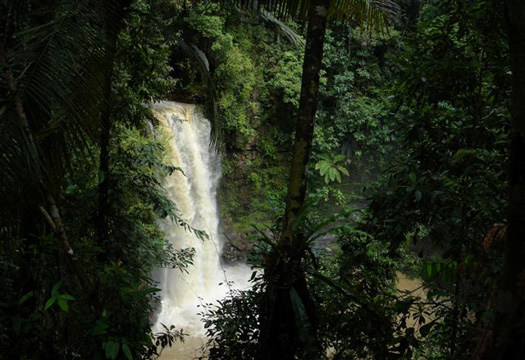
Ginseng Falls
Pete will not thank me for publishing this photo, I suspect [ Ed 🙂 ]
Related Posts
%RELATEDPOSTS%

